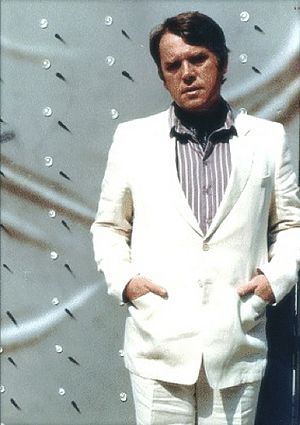Georg Klusemann facts for kids
Georg Klusemann (born May 13, 1942, in Essen, Germany – died May 4, 1981, in Pisa, Italy) was a very creative artist and a children's book author. Even though he passed away at only 38 years old, Klusemann created a huge amount of art and stories.
Contents
Discovering Georg Klusemann's Art
Georg Klusemann was an artist who loved Italy. His work shows how much he was inspired by Italian culture. He studied art at the Kunstakademie Düsseldorf from 1962 to 1968. Some of his classmates were famous artists like Katharina Sieverding and Jörg Immendorff.
After traveling a lot to places like Spain, the Middle East, and Latin America, his art became truly unique. He took ideas from other artists like Joan Miró and Victor Vasarely, and from art styles like Surrealism. But he always made these ideas his own. His art doesn't fit into just one known style.
Art critics have described his work in many ways. They called him "Baroque" (meaning very detailed and grand) and "indefatigable and fantastic" (meaning tireless and full of imagination). Some said his art was like the famous painter Arcimboldo, who made portraits out of fruits and vegetables. Others noted how he mixed abstract art with realistic scenes.
A famous writer about Surrealism, Patrick Waldberg, said Klusemann's art was "full of waving drapes, flying boxes, objects coming up in the air, swelling balloons, windows bursting open, instruments coming to life." He said all this happened "according to a harmony beyond logic." This means his art was imaginative and dreamlike.
Klusemann's Creative Works
Georg Klusemann was a painter, a drawer, an etcher (who makes prints), and a children's book author. He created at least 350 paintings, 330 etchings, and hundreds of drawings and watercolors. He also wrote poems and fables.
His children's books were published by Beltz & Gelberg and Peter Hammer Verlag. These books are still used in German elementary schools. This is because they are fun and imaginative, helping kids learn about different cultures.
Many books have been written about his art. In the year 2000, all his complete works were published in two large books.
Exhibitions and Collections
Georg Klusemann's paintings and etchings have been shown in over 40 exhibitions. These shows took place in countries like France, Spain, Italy, Germany, Venezuela, and the U.S.A.
Some of his biggest art shows were at the Museum Folkwang in Essen, the Kunstverein für die Rheinlande und Westfalen in Düsseldorf, and the Goethe-Institut in New York. His art was also displayed at the Bagatti Valsecchi Museum in Milan and the Museo d'arte contemporanea Villa Croce in Genoa.
His artworks are part of important museum collections around the world. You can find his pieces at the Metropolitan Museum of Art and the Museum of Modern Art in New York. His art is also in the Albertina in Vienna, the Rheinische Landesmuseum in Bonn, and the Museo de Bellas Artes in Caracas. Many private collectors also own his works.
In 1994, a children's opera was created based on his book Die wundersame Reise nach Esmir (The Wonderful Journey to Esmir). It was first performed at the Ruhrfestspielhaus in Recklinghausen.
Georg Klusemann's Life Journey
Georg Klusemann was born in a part of Essen, Germany, called An der Kluse. This area is near the historic Klusenkapelle.
In 1968, he met Elena Hochman-Klusemann. They later moved to Tuscany, Italy.
His daughter, Caterina Klusemann, made a documentary film about his life called Georg. It was completed in 2008. In the film, friends and fellow artists share their memories of him. These include the painter Ulrich Erben, the writer Ingrid Bachér, the writer Hermann Schulz, and his publisher Hans-Joachim Gelberg. His wife also shares her story, helping to show his short but very full life.
- Works by and about Georg Klusemann in the German National Library catalogue


